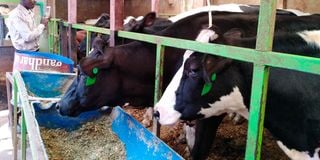When feeds make dairy cows rot from inside

Dairy cattle feed on a farm Ms Trizah NJeri's farm in Ikinu, Githunguri.
I had not visited Kariuki’s dairy farm in Nakuru for several months, but last week he called while in distress. He said his manager would furnish me with the details of a problem they had not seen on the farm before.
He, however, summarised the issue ominously. The cows lost weight over time when pregnant then deteriorated after calving and died. On opening the carcasses, the animals appeared to be rotting from the inside.
Daniel, the farm manager, called a day later and painted the picture of a herd that was slowly fading away. He said they had in recent months lost a number of cows. The animals appeared to be normal during the early dry period. However, as they were being steamed for calving; they would start losing weight and sometimes go off feed.
Soon after calving, cows would have periods of good and poor appetite without any specific pattern. They lost weight and finally died. Post-mortem examination showed rotting of the rumen, froth in the lungs and abscesses in the liver. The livers would also be hard with a lot of fibrous tissue. Local animal service providers treated the animals for bacterial infection without success.
The farm manager said the disease only affected the cattle under steaming and the newly calved. He wondered why the animals were rotting from inside and failing to respond to treatment. I asked Daniel to send me pictures and video clips of the cases.
Herd problems are never diagnosed on phone because in most instances, they are occasioned by multiple factors. The doctor needs to make observations on the animals and their environment. The case history must also be recorded from the farms narrations, records of activities and events on the farm.
Extensive ulceration
I reviewed some pictures that Daniel sent on WhatsApp. There was consistent and extensive ulceration of the rumen, the largest of the four stomachs of a cow. The ulcers were in different stages of formation and healing. This meant they were a continuous process. None of the ulcers appeared to perforate the rumen wall.
The livers were hard and shrunken with scars and some abscesses. The lungs were also shrunken and contained white frothy material. I quickly put up a mental plan for investigating the problem.
While on the farm, I first visited the feed processing unit. Daniel explained the animals were fed on total mixed ration (TMR) and supplemented with wet lucerne. The TMR comprised corn, Boma Rhodes hay, corn silage, protein concentrate, dairy meal, minerals and vitamins.
TMR is the most recommended method of feeding zero-grazed dairy cattle. I proceeded to the cattle barn starting with the milkers. I found them feeding on the TMR. There was an obvious issue with the feeding behaviour.
The cows dug their muzzles deep into the TMR heaps leaving holes in the feed and the hay was untouched. This is called sorting behaviour. It indicates that the cattle were looking for the small particles of dairy meal, corn, silage and protein concentrate. I alerted Daniel of the problem.
The hay for the TMR had been chopped in large sections above 10cm. Normal size for good TMR should be around 4mm. Long hay pieces prevent proper mixing of the TMR. When the feed is served, the small particles drop to the bottom of the heap while the long hay pieces are left on top.
These pieces are unpalatable to the cattle. They, therefore, eat the small sweet components of the feed first and return to the hay later. Daniel told me that eventually after several hours, the animals finished their rations.
Second, I looked at the dung produced by the cows. A few had high quality greenish – yellow well-formed faeces but others had various types of abnormal colour and consistency. All the animals looked generally unhappy and their coats were not shiny as they had been in my last visit.
Dairy meal
Daniel said the animals were fed on about 9kg of dairy meal, 9–15kg of silage, 3kg of hay and about 3kg of lucerne daily depending on each cow’s milk yield. I explained to him the whole problem was feeding and feed formulation. The cows were eating too much carbohydrate at once and were in a constant state of too much lactic acid in the rumen for prolonged periods of time.
I examined one pregnant cow that was off feed and looking very dull. With the help of a stethoscope, the chest and heart area felt like it contained ducks that were swimming. There were sounds of fluid splashing and flowing. That indicated the chest and the cavity surrounding the heart were full of fluid. The cow had a fever of 40.5 degrees centigrade and could not bend when I pinched at the shoulders. I could also not pick up the heart sounds.
I diagnosed advanced infection of the chest and heart by bacteria from the rumen. Such animals rarely recover. I recommended slaughter for human consumption if passed at meat inspection. The cow has since deteriorated and died. The fluid and infection was confirmed at post-mortem examination. Internal organs had rotten badly.
I explained to Daniel the whole herd was suffering from a condition called Subacute Rumen Acidosis (SARA) due to improper feed formulation and feeding. I will explain SARA and its treatment in the next article.





